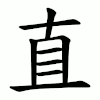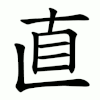直
| ||||||||
 | ||||||||
| ||||||||
| ||||||||
Translingual
| Stroke order (Chinese) | |||
|---|---|---|---|
 | |||
| Stroke order (Japan) | |||
|---|---|---|---|
 | |||
| Stroke order (Japan) | |||
|---|---|---|---|
Alternative forms
Note the different forms, which differ in two respects: both Simplified and Traditional do not have a left vertical stroke, while the orthodox form has a left vertical stroke; and in simplified form, the top component is connected with the bottom, while in the orthodox they are separated – this last difference is shared with unrelated characters 真 and 具. The older form and stroke order are officially used in Japan and South Korea but an alternative writing in other countries.
Han character
| Traditional | 直 |
|---|---|
| Simplified | 直 |
| Japanese | 直 |
| Korean | 直 |
直 (Kangxi radical 109, 目+3, 8 strokes, cangjie input 十月一一 (JBMM), four-corner 40716, composition ⿱十⿴𠀃三(GH) or ⿱𠂇⿴𠀃三(TV) or ⿱𠂇⿺𠃊目(JK))
Derived characters
See also
References
- KangXi: page 800, character 5
- Dai Kanwa Jiten: character 23136
- Dae Jaweon: page 1215, character 1
- Hanyu Da Zidian (first edition): volume 1, page 61, character 7
- Unihan data for U+76F4
- Unihan data for U+FAA8
- Unihan data for U+2F940
Chinese
| simp. and trad. |
直 | |
|---|---|---|
| 2nd round simp. | 𰅰 | |
| alternative forms | ⿱十且 1981 | |
Glyph origin
| Historical forms of the character 直 | |||
|---|---|---|---|
| Shang | Western Zhou | Shuowen Jiezi (compiled in Han) | Liushutong (compiled in Ming) |
| Oracle bone script | Bronze inscriptions | Small seal script | Transcribed ancient scripts |
 |
 |
 |
 |
Oracle bone script: Ideogrammic compound (會意) : 目 (“eye”) + 丨 (“vertical stroke”) – vertical stroke above the eye; looking straight ahead.
The line on the side appears in bronze script and subsequently stretched under the 目 shape, while the traditional form appears in seal script.
Etymology
- "simply; only"
- According to Schuessler (2007), cognate with 特 (OC *dɯːɡ, “single”). Also compare Darmiya taku (“one”).
- "straight; right"
- According to STEDT, from Proto-Sino-Tibetan *m-tjak/ŋ ~ tik/ŋ (“good; very; real; straight”), which also includes 正 (OC *tjeŋ, “first (lunar month)”), 正 (OC *tjeŋs, “straight; correct”), 政 (OC *tjeŋs, “government; rule”) and 實 (OC *ɦliɡ, “solid; true”). Cognates include Tibetan ཏིག་ཏིག (tig tig, “certainly”), Mizo dik (“correct”), Proto-Lolo-Burmese *N-d(y)ak (“truly; very; intensitive”). An allofam is probably 德 (OC *tɯːɡ, “virtue”) (Schuessler, 2007).
- “heterosexual”
- Semantic loan from English straight.
Pronunciation
Definitions
直
- straight; linear; undeviating
- to straighten
- vertical; upright; erect
- honest; fair
- straightforward; forthright; frank
- directly; straight
- 直去 ― zhíqù ― to go directly to
- intentionally; deliberately
- † only; just
- Synonym: 只 (zhǐ)
- (Chinese calligraphy) vertical stroke in Chinese characters
- † Alternative form of 值 (zhí, “to be worth”).
- constantly
- (slang) straight; heterosexual
- (historical) Short for 直隸/直隶 (Zhílì, “Zhili”).
- 直系軍閥/直系军阀 ― Zhí xì jūnfá ― the Zhili faction (of the Beiyang warlords)
- a surname
Synonyms
| Variety | Location | Words |
|---|---|---|
| Formal (Written Standard Chinese) | 豎 | |
| Mandarin | Beijing | 豎 |
| Jinan | 豎 | |
| Xi'an | 豎, 順, 立 | |
| Wuhan | 豎, 直 | |
| Chengdu | 豎, 立 | |
| Guiyang | 豎, 直 | |
| Yangzhou | 豎 | |
| Hefei | 豎 | |
| Cantonese | Guangzhou | 掂, 戙 |
| Hong Kong | 直, 掂, 戙 | |
| Yangjiang | 掂, 直 | |
| Gan | Nanchang | 敦, 直 |
| Hakka | Meixian | 直 |
| Jin | Taiyuan | 豎 |
| Min Bei | Jian'ou | 直 |
| Min Dong | Fuzhou | 直, 徛 |
| Min Nan | Xiamen | 徛 |
| Chaozhou | 徛, 直 | |
| Wu | Suzhou | 直, 豎 |
| Wenzhou | 豎 | |
| Xiang | Changsha | 敦, 直 |
| Shuangfeng | 敦, 直 | |
Compounds
|
|
|
References
- Dictionary of Chinese Character Variants (教育部異體字字典), A02759
- “Entry #4389”, in 臺灣閩南語常用詞辭典 [Dictionary of Frequently-Used Taiwan Minnan] (in Chinese and Min Nan), Ministry of Education, R.O.C., 2011.
Japanese
Readings
- Go-on: じき (jiki, Jōyō)←ぢき (diki, historical); じか (jika)←ぢか (dika, historical)
- Kan-on: ちょく (choku, Jōyō)
- Kun: ただちに (tadachini, 直ちに, Jōyō); なおす (naosu, 直す, Jōyō)←なほす (nafosu, 直す, historical); なおる (naoru, 直る, Jōyō)←なほる (naforu, 直る, historical); あたい (atai, 直)←あたひ (atafi, 直, historical); すぐ (sugu, 直ぐ); すぐ (sugu, 直); なおき (naoki, 直き)←なほき (nafoki, 直き, historical); じか (jika, 直); ひた (hita, 直)
- Nanori: すぐ (sugu); なおい (naoi); のう (nō); のお (nō)
Compounds
Etymology 1
| Kanji in this term |
|---|
| 直 |
| じか Grade: 2 |
| kun’yomi |
Sound change from jiki.[1]
This etymology is incomplete. You can help Wiktionary by elaborating on the origins of this term.
Related terms
- 直に (jika ni)
Etymology 2
| For pronunciation and definitions of 直 – see the following entry. | ||
| ||
| (This term, 直, is an alternative spelling of the above term.) |
Etymology 3
| Kanji in this term |
|---|
| 直 |
| ちょく Grade: 2 |
| kan’on |
Adjective
直 • (choku) †-tari (adnominal 直とした (choku to shita) or 直たる (choku taru), adverbial 直と (choku to) or 直として (choku to shite))
Verb
直する • (choku suru) suru (stem 直し (choku shi), past 直した (choku shita))
- to do one's duty, be on duty
Conjugation
| Katsuyōkei ("stem forms") | ||||
|---|---|---|---|---|
| Mizenkei ("imperfective") | 直し | ちょくし | choku shi | |
| Ren’yōkei ("continuative") | 直し | ちょくし | choku shi | |
| Shūshikei ("terminal") | 直する | ちょくする | choku suru | |
| Rentaikei ("attributive") | 直する | ちょくする | choku suru | |
| Kateikei ("hypothetical") | 直すれ | ちょくすれ | choku sure | |
| Meireikei ("imperative") | 直せよ¹ 直しろ² |
ちょくせよ¹ ちょくしろ² |
choku seyo¹ choku shiro² | |
| Key constructions | ||||
| Passive | 直される | ちょくされる | choku sareru | |
| Causative | 直させる 直さす |
ちょくさせる ちょくさす |
choku saseru choku sasu | |
| Potential | 直できる | ちょくできる | choku dekiru | |
| Volitional | 直しよう | ちょくしよう | choku shiyō | |
| Negative | 直しない | ちょくしない | choku shinai | |
| Negative continuative | 直せず | ちょくせず | choku sezu | |
| Formal | 直します | ちょくします | choku shimasu | |
| Perfective | 直した | ちょくした | choku shita | |
| Conjunctive | 直して | ちょくして | choku shite | |
| Hypothetical conditional | 直すれば | ちょくすれば | choku sureba | |
| ¹ Written imperative ² Spoken imperative | ||||
References
- 1995, 大辞泉 (Daijisen) (in Japanese), Tōkyō: Shogakukan, →ISBN